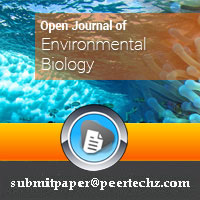Open Journal of Environmental Biology
Antioxidants and Ageing
Biswaranjan Paital*, Tallat Jahan, Sthiti pragyan Priyadarshini and Ankita Mohanty
Cite this as
Biswaranjan P, Jahan T, Priyadarshini S, Mohanty A (2017) Antioxidants and Ageing. Open J Environ Biol 2(1): 025-026. DOI: 10.17352/ojeb.000004Editorial
Antioxidants are the molecules that reduce the chance of ageing by diminishing or maintaining the level of oxidants with or without free radical activity. Therefore, to many people, “antioxidants” and “anti-aging” go hand-in-hand. Antioxidants can be supplied with dietary supplements for body, or can be used in cosmetics for skin, can be touted as the antidote to cell-damaging free radicals and finally, they act as the key to long-lasting youth. Although, present study reveals a complicated relation between aging and antioxidants, the rate of ageing is predicted to be more important than lifespan. Therefore, in a life span, slowing the process of ageing is more important.
The term “antioxidant and aeging” hits all total 16807 articles in PubMed [1] and all total 1,28,00,000 results in Google [2] and 17,600 scholarly articles in Google scholar [3] and hits 897 articles in PubMed in last year i.e. from 2016 to 2017 May [4]. The first article i.e. 16807th one in PubMed, was published in 1946 by Caldwell and Hughes [5], describing about the role of vit-A on ageing induced change in carotenoid pigment. The latest research carried out on this topic was about the treatment of aging induced skin wrinkles by nano-antioxidant formulations [6]. From the research carried out at biochemical and molecular level since 1946 to 2017 on the topic “antioxidants and ageing”, many biomolecules and chemicals having redox properties have been identified to minimize ageing process. In addition, some of the ageing related complications also have been targeted using antioxidant therapy as one of the most common clinical approaches. It indicates many significant roles of antioxidants or redox regulatory molecules in animals to slow down aeging and related issues. Many hypotheses on regulating ageing and its consequences have been examined for the sake of animal and human wellbeing. However, research highlights that many more need to be done on this particular area as it is still obscure if ageing can be slower down [7]. May be this is the reason many specific journals (with high citations) related to antioxidants, ageing and oxidative stress (one of the outcome of lowered antioxidant level in body) have been established to focus on this area.
To resolve above discussed issues on ageing, what is the next step? Is it that much simple to prescribe more dietary antioxidant or any other sources of antioxidants, or to lower down the production of oxidants in cells? As per, Siegfried Hekimi, a molecular geneticist at McGill University, “You do not need to have lowered free radical production to live long”. One of the reasons is, non- free radicals oxidants such as hydrogen peroxide have also many fold attribution in several signal transduction processes. So, one cannot think of lowering them in body. It is the life style one need to change to regulate unnecessary production of oxidants in body. So, it is like prevention is better than cure. A healthy life style therefore, is advised to restrict many unwanted issues related to aeging and other complications such as cardiovascular problems, brain malfunction and nerve related complications [8,9]. At such a stage of having more chance of premature aged population in future, animal and plant sources of antioxidants and vitamins are more preferred and therefore, suggested to be more researched.
BRP is highly thankful to the Science and Engineering Research Board, Department of Science and Technology, Govt. of India New Delhi, India for providing funding (No. ECR/2016/001984) related to the topic of this article.
- Link: https://goo.gl/tYVclt
- Link: https://goo.gl/38CgqL
- Link: https://goo.gl/XVemWD
- Link: https://goo.gl/vPjXm7
- Caldwell MJ, Hughes JS (1946) Changes in the absorption spectra due to aging of the Carr-Price reaction mixture with vitamin A and the common carotenoid pigment. J Biol Chem 166: 565-572. Link: https://goo.gl/tUhOln
- Heydari S, Ghanbarzadeh S, Anoosh B, Ranjkesh MR, Javadzadeh Y, et al. (2017) Nanoethosomal Formulation of Gammaoryzanol for Skin-Aging Protection and Wrinkle Improvement: a histopathological study. Drug Dev Ind Pharm 3: 1-31. Link: https://goo.gl/rwp6tb
- Furue M, Uchi H, Mitoma C, Hashimoto-Hachiya A, Chiba T, et al. (2017) Antioxidants for Healthy Skin: The Emerging Role of Aryl Hydrocarbon Receptors and Nuclear Factor-Erythroid 2-Related Factor-2. Nutrients 3: 9. Link: https://goo.gl/L52ljv
- Zakhari S, Malnick S, Seitz HK, Cohen LB, Salaspuro M, et al. (2017) Alcohol, microbiome, life style influence alcohol and non-alcoholic organ damage. Exp Mol Pathol 102: 162-180. Link: https://goo.gl/O8lbDN
- Papaioannou TG, Karatzi K, Psaltopoulou T, Tousoulis D (2016) Arterial ageing: Major nutritional and life-style effects. Ageing Res Rev. Link: https://goo.gl/5QiiJJ

Article Alerts
Subscribe to our articles alerts and stay tuned.
 This work is licensed under a Creative Commons Attribution 4.0 International License.
This work is licensed under a Creative Commons Attribution 4.0 International License.
 Save to Mendeley
Save to Mendeley
